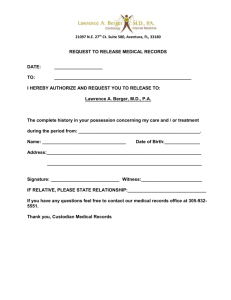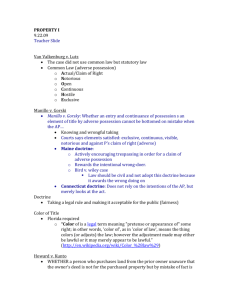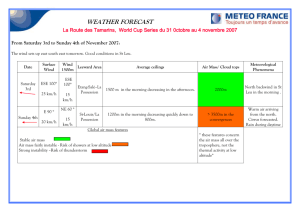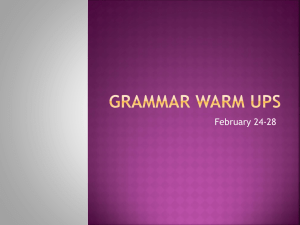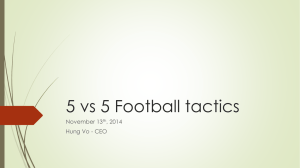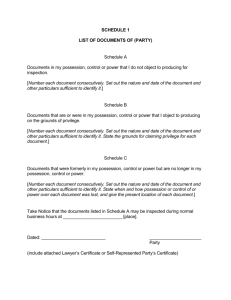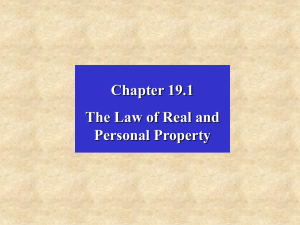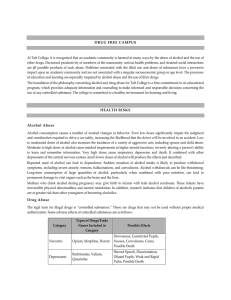Basic Drug Facts Card Game
advertisement
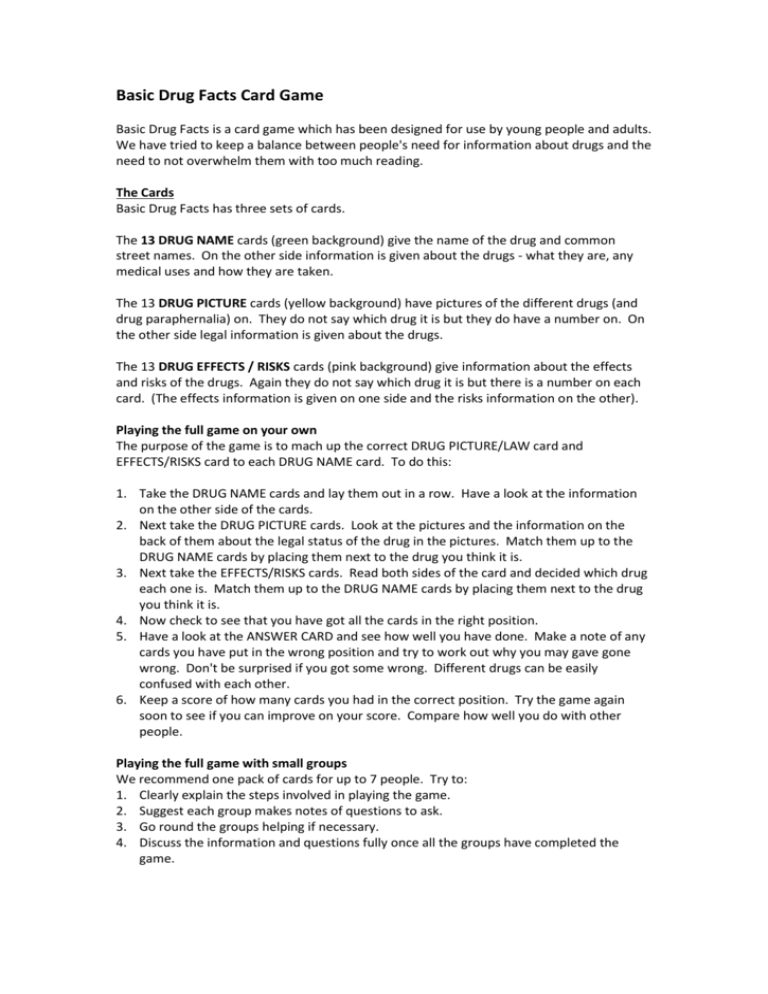
Basic Drug Facts Card Game Basic Drug Facts is a card game which has been designed for use by young people and adults. We have tried to keep a balance between people's need for information about drugs and the need to not overwhelm them with too much reading. The Cards Basic Drug Facts has three sets of cards. The 13 DRUG NAME cards (green background) give the name of the drug and common street names. On the other side information is given about the drugs - what they are, any medical uses and how they are taken. The 13 DRUG PICTURE cards (yellow background) have pictures of the different drugs (and drug paraphernalia) on. They do not say which drug it is but they do have a number on. On the other side legal information is given about the drugs. The 13 DRUG EFFECTS / RISKS cards (pink background) give information about the effects and risks of the drugs. Again they do not say which drug it is but there is a number on each card. (The effects information is given on one side and the risks information on the other). Playing the full game on your own The purpose of the game is to mach up the correct DRUG PICTURE/LAW card and EFFECTS/RISKS card to each DRUG NAME card. To do this: 1. Take the DRUG NAME cards and lay them out in a row. Have a look at the information on the other side of the cards. 2. Next take the DRUG PICTURE cards. Look at the pictures and the information on the back of them about the legal status of the drug in the pictures. Match them up to the DRUG NAME cards by placing them next to the drug you think it is. 3. Next take the EFFECTS/RISKS cards. Read both sides of the card and decided which drug each one is. Match them up to the DRUG NAME cards by placing them next to the drug you think it is. 4. Now check to see that you have got all the cards in the right position. 5. Have a look at the ANSWER CARD and see how well you have done. Make a note of any cards you have put in the wrong position and try to work out why you may gave gone wrong. Don't be surprised if you got some wrong. Different drugs can be easily confused with each other. 6. Keep a score of how many cards you had in the correct position. Try the game again soon to see if you can improve on your score. Compare how well you do with other people. Playing the full game with small groups We recommend one pack of cards for up to 7 people. Try to: 1. Clearly explain the steps involved in playing the game. 2. Suggest each group makes notes of questions to ask. 3. Go round the groups helping if necessary. 4. Discuss the information and questions fully once all the groups have completed the game. Other ways of using the cards 1. Take some cards out. For example you could play the full game with only 8 drugs rather that the full 13. 2. With large groups you could split the game into two (say 7 drugs and 6 drugs) and let small groups play half the game and then swap over to do the other half. 3. Only use two sets of cards - eg omit the DRUG PICTURE or EFFECTS/RISKS cards. 4. Use the DRUG NAME cards and rank them on scales such as: Most used by young people Least used by young people Most used by adults Least used by adults Most harmful Least harmful Most easily available Least easily available Most expensive Least expensive OR put them in two piles such as: LEGAL TO USE ……………………………………….……..ILLEGAL TO USE I KNOW A LOT ABOUT IT …………………. …I KNOW LITTLE ABOUT IT PRESCRIBED BY DOCTORS …………….NOT PRESCRIBED BY DOCTORS These activities can be carried out by small groups who can them compare what they think. For a whole group activity people can be given one card each and asked to stand in a line with MOST at one end of the line and LEAST at the other end. 5. In a large group you could give out the DRUG NAME cards and DRUG PICTURE cards, one per person. People then walk around and try to meet up with the correct partner. This can also be done using the law side of the DRUG PICTURE cards or the EFFECTS/RISKS cards. Drugs and the Law Drugs laws are complicated. The main law is the MISUSE OF DRUGS ACT. (MDA). This divides drugs into Classes A, B and C. Class A: cocaine & crack (a form of cocaine), ecstacy, heroin, LSD, Methodone and 'processed' magic mushrooms and any Class B drug which is injected. Class B: amphetamine, barbiturates, cannabis and codeine. Class C: mild amphetamines, tranquillisers and anabolic steroids. Class A drugs are regarded as the most dangerous. Some drugs (such as heroin, methadone, amphetamine and barbiturates) may be given to people on prescription and then there is no possession offence. Offences can include possession, possession with intent to supply others, supplying others and production. Supplying attracts harsher penalties than possession. The maximum penalty for possession of a Class B drug is 5 years imprisonment and a fine, with up to 14 years imprisonment and a fine for supply. The equivalent maximum penalties for Class A drugs are 7 years and a fine for possession and life imprisonment and a fine for supplying. Magic mushrooms are not illegal to pick, possess or use in their raw state. If they are processed (dried out and stored, cooked with, made into a tea etc) they can become a Class A drug.


